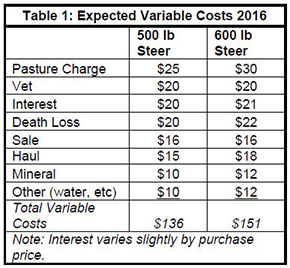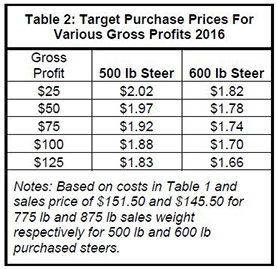Kentucky Ag News
Summer stocker outlook: Pay close attention to costs, risk management in volatile beef cattle market
University of Kentucky College of Agriculture, Food and Environment
LEXINGTON, Ky. - With the warmer temperatures and the start of spring grass growth, stocker operators are contemplating placement of calves into summer programs. As is often the case, calf prices have risen over the last several weeks as we have gotten closer to grazing time. Some operations likely placed calves during the winter, with the intention of purchasing stockers before the typical spring price peak. However, many more will place calves as pastures green up in the coming weeks. It is imperative that stocker operators pay careful attention to the market, their costs, and what can be paid for stocker calves this spring.
Last summer was a challenging year for stocker operators who chose not to utilize some form of price protection on the calves they grazed. Many of them gave back a considerable share of the profit they made during 2014 as the feeder cattle market dropped sharply from summer through the end of the fall. However, stocker operators who protected sale prices were able to see positive returns last year as the market was offering profit opportunities in the spring. We actually feel like many stocker operators were a bit overconfident following 2014 and took on more risk because of it. The last two years were excellent examples of how much volatility can be present in feeder cattle markets during the summer. While it is impossible to predict the direction of feeder cattle markets in the current year, producers can use the current CME© feeder cattle futures market as an indication of what can be paid for calves to be placed on grass this spring and sold this fall. The purpose of this article is to assess the likely profitability of summer stocker programs for 2016 and establish target purchase prices for calves based on a range of target return levels.
Fall CME© feeder cattle futures (adjusted for basis) are typically the best way to estimate likely feeder cattle values for fall, which is the expected revenue for a summer stocker program. Grazing costs, including pasture costs, veterinary and health expenses, hauling, commission, etc. can be estimated and subtracted from the expected value of the fall feeders. Once this has been done, a better assessment can be made of what can be paid for stocker cattle this spring in order to build in an acceptable return to management, capital, and risk.
Key assumptions for the stocker analysis are as follows: 1) Graze steers April 1 to October 1 (183 days), 1.5 pound/day gain (no grain feeding), 2% death loss, and 4% interest on calves. Given these assumptions, sale weights would be 775 pounds and 875 pounds for 500-pound and 600-pound purchased calves, respectively. Using a $159 CME© futures contract for October 2015 to estimate sales price, a 775 steer is estimated to sell for $151.50, and an 875 steer is estimated to sell for $145.50. This amounts to a $6 per cwt price slide for heavyweight steers. We have reduced price slide expectations from last year as the feeder cattle market is at considerably lower levels that it was at one year ago. These sale prices are also based on the assumption that cattle are sold in lots of 40 or more head. Stocker operators who typically sell in smaller lots should adjust their expected sale prices downward accordingly.

Estimated costs for carrying the 500- and 600-pound steers are shown in Table 1. Most of these are self-explanatory except the pasture charge. Stocking rates of 1.0 acre per 500-pound steer and 1.2 acres per 600-pound steer were assumed in arriving at these charges. The pasture charge accounts for variable costs such as mowing, fertilizer, and re-seeding. The last of these pasture costs are on a pro-rated basis and are considered a bare-bones scenario. Sale expenses (commission) are based on the assumption that cattle will be sold in larger groups and producers will pay the lower corresponding commission rate. However, producers who sell feeders in smaller groups will pay the higher commission rate, which will likely be around $40 per head based on the revenue assumptions of this analysis. This continues to be a challenge for small operators in this high-priced market. Any of these costs could be much higher in certain situations, so producers should adjust accordingly.

Target purchase prices were estimated for both sizes of steers and adjusted so that gross returns over variable costs ranged from $25-125 per head. This gives a reasonable range of possible purchase prices for each sized animal this spring. Results are shown in Table 2. For 500-pound steers, target purchase prices ranged from $1.83 to $2.02 per pound. For 600-pound steers, target purchase prices ranged from $1.66 to $1.82 per pound. When targeting a $100-per-head gross profit, break-even purchase prices were $1.88/pound for 500-pound steers and $1.70/pound for 600-pound steers.
Of course, it is highly likely that your cost structure will be different than that presented in Table 1. If this is the case, simply shift the targeted gross profit up or down to account for this. If your costs are $25 higher per calf, then you would shift each targeted profit down by one row: For example, you would use the $125 gross profit to estimate a $100 gross profit. Another way to evaluate this is that a $1 increase in costs would decrease the targeted purchase price by $0.20 per cwt for 500-pound steers and $0.17 per cwt for 600-pound steers.
It is important to note that the gross profits in Table 2 do not account for labor or investments in land, equipment, fencing, and other facilities (fixed costs). Thus, in the long run, these target profits need to be high enough to justify labor and investment. In many locations, calf markets are already at levels that would place expected returns on the lower end of the range analyzed. This is all the more reason that stocker operators should carefully think through their budgets and make rational purchasing decisions.
While the current calf market is nowhere near where it was last spring, it is still a historically strong spring market. Further, there is potential for calf prices to move even higher in the next few weeks. So, summer grazers will have a lot of money invested in calves that are placed into grazing programs this spring. Furthermore, if we have learned anything over the last few years, it is that feeder cattle markets are highly volatile, especially during the corn growing season. Thus, price risk management will be critical as calves are placed this spring and stocker operators seek to protect downside price risk.
Hedging, through the sale of futures contracts provides solid downside risk protection but will subject the producer to margin calls if cattle prices increase. This was a serious challenge for many who employed this strategy during the summer of 2014. Entering a cash forward contract with a feedlot or order buyer, or offering cattle through Internet sales with delayed delivery, will reduce or eliminate price uncertainty, but will also limit marketing flexibility should weather conditions necessitate sale at a different time. Finally, strategies such as put options and Livestock Risk Protection (LRP) Insurance offer a less aggressive strategy that provides some downside price protection, but more ability to capitalize on rising prices.
Regardless of what makes the most sense for the individual producer, time spent considering price risk management is likely time well spent in these volatile markets. Links to two publications on using futures markets to manage price risk in feeder cattle and a publication on the use of Livestock Risk Protection (LRP) Insurance, can be found on the livestock page of the UK Agricultural Economics website: http://www.uky.edu/Ag/AgEcon/extcrops-livestock.php.
The best way to ensure profitability is to budget carefully and to manage downside price risk. It is our opinion that if you are not occasionally leaving some money on the table through your risk management strategy, you are probably taking too much risk in your operation.
This article was written by Greg Halich and Kenny Burdine, agriculture economists at the University of Kentucky College of Agriculture, Food and Environment. The article first appeared in the March 25 edition of Economic and Policy Update.














